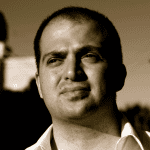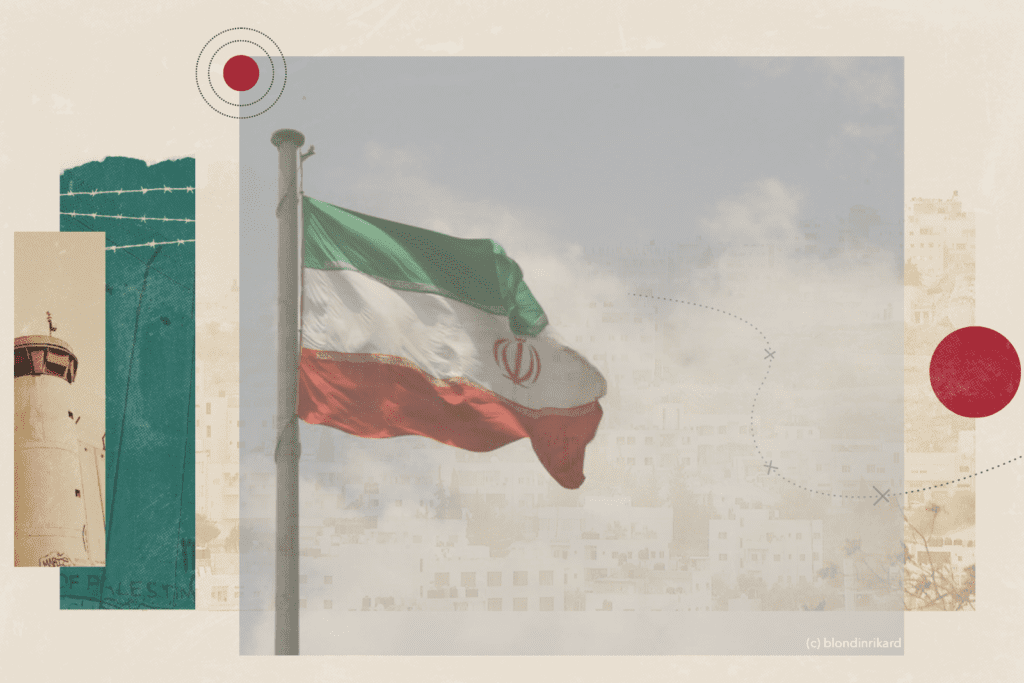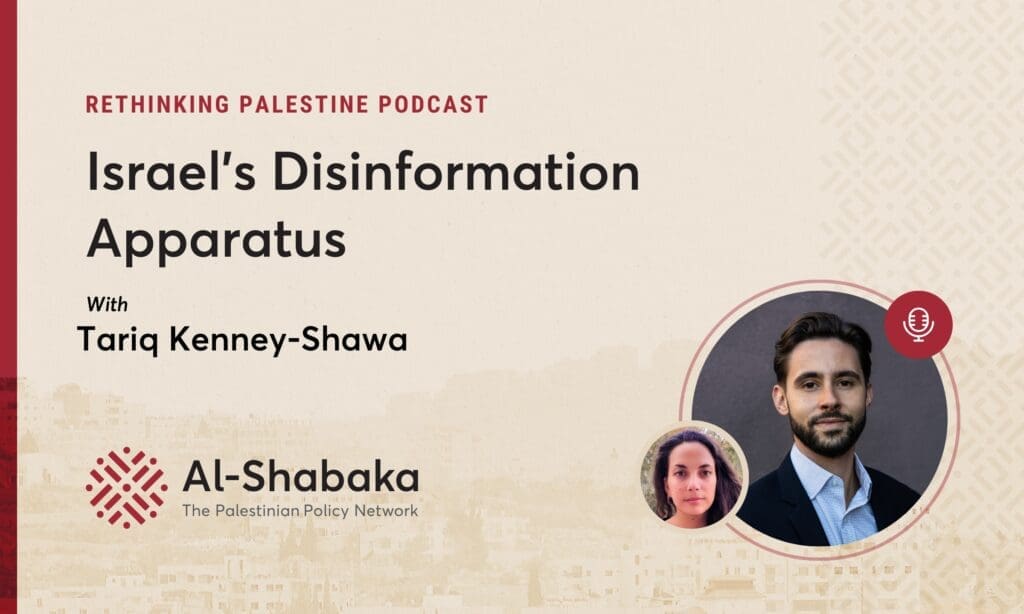- Topics
-
Topics
See our analysis on civil society and how it shapes culture, politics, and policies
Read our insights on the shifting political landscape and what it means for Palestine
Learn more about the policies and practices shaping the Palestinian economy
Strengthen your understanding of the unique conditions for Palestinian refugees across the Middle East
-
- Analysis
-
Analysis
In-depth analysis on existing or potential policies that impact possibilities for Palestinian liberation.
Insights and perspectives on social, political, and economic questions related to Palestine and Palestinians globally.
Concise analysis into a specific policy, its background and implications.
Commentary that brings together insights from multiple analysts.
Compilations of past Al-Shabaka works surrounding a specific theme.
Longer-form, ad hoc projects that seek to confront research questions outside the scope of our regular analysis.
A policy-driven research initiative by Al-Shabaka: The Palestinian Policy Network.
Our monthly webinar series that brings together Palestinian experts.
Featured
While it remains unclear how and when Israel will respond to Iran’s operation, geopolitics have undoubtedly already shifted. In this roundtable, Al-Shabaka analysts Fadi Quran, Fathi Nimer, Tariq Kenney-Shawa, and Yara Hawari offer insights on the regional impact of Iran’s recent maneuver and situate the ongoing genocide in Gaza within this broader context.


 +Mainstream media coverage of the genocide in Gaza throughout the West has highlighted not only deep biases in favor of the Israeli regime, but also the ease in which Palestinians are dehumanized. In this commentary, Yara Hawari details Israel’s strategy to strip Palestinians of their humanity in the public realm, as well as the role of Western media in advancing Israel’s aims. She reveals consistent patterns of journalistic malpractice since October 7, 2023, and concludes that the Western outlets are inescapably complicit in the Israeli regime’s genocide against the Palestinian people of Gaza.
+Mainstream media coverage of the genocide in Gaza throughout the West has highlighted not only deep biases in favor of the Israeli regime, but also the ease in which Palestinians are dehumanized. In this commentary, Yara Hawari details Israel’s strategy to strip Palestinians of their humanity in the public realm, as well as the role of Western media in advancing Israel’s aims. She reveals consistent patterns of journalistic malpractice since October 7, 2023, and concludes that the Western outlets are inescapably complicit in the Israeli regime’s genocide against the Palestinian people of Gaza. Yara Hawari· Apr 3, 2024Tariq Kenney-Shawa, Al-Shabaka’s US policy fellow, joins host Yara Hawari to discuss Israel’s information warfare tactics, used to influence public perception of its ongoing genocide in Gaza.
Yara Hawari· Apr 3, 2024Tariq Kenney-Shawa, Al-Shabaka’s US policy fellow, joins host Yara Hawari to discuss Israel’s information warfare tactics, used to influence public perception of its ongoing genocide in Gaza.
-
- Resources
- Media & Outreach
- The Network





Radical Futures: When Palestinians Imagine
“We must tell stories that are different from the ones we’re being brainwashed to believe…Remember this: another world is not only possible, she is on her way.”
– Arundhati Roy1
Overview
Facing a constant process of erasure, Palestinians find themselves in a situation in which their past and their futures are denied. They are locked in a continuous present in which the settler colonial power, Israel, determines temporal and spatial boundaries. Palestinians often refer to this as the Nakba al mustamirrah, or the continuous Nakba, in which displacement, dispossession, and destruction occur on a never-ending continuum. It is this continuity of Nakba that has rendered it difficult for Palestinians to think about the future: Surviving the ever-deteriorating present, particularly in Palestine itself, takes priority.2
This commentary highlights scholarship on colonialism and imagining radical futures, and then traces articulations of the future that suppress Palestinians. It concludes with examples of how Palestinians, despite their subjugation, continue to radically imagine, and calls for a future built from Palestinians’ collective visions.
Colonialism and Perceptions of Reality
Frantz Fanon wrote that French colonialism in Algeria “always developed on the assumption that it would last forever,” noting that “the structures built, the port facilities, the airdromes, [and] the prohibition of the Arab language” all gave the impression that a rupture in the colonial time was impossible. Indeed, “every manifestation of the French presence expressed a continuous rooting in time and in the Algerian future, and could always be read as a token of an indefinite oppression.” visions.
Similarly, the Israeli regime creates “facts on the ground” through continued settlement building in the West Bank and the appropriation of land across the Green Line, constantly moving the boundaries of what is accepted as Israeli land in favor of the settler colonial regime.
Settler colonial and colonial projects thus seek to control perceptions of reality in order to bind Indigenous and colonized people in a seemingly perpetual state of being, or normalized stasis. Imagining a future beyond this state is thus a rebellious and radical act, and is by no means an easy one.
Settler colonial and colonial projects seek to control perceptions of reality in order to bind Indigenous and colonized people in a seemingly perpetual state of being Click To TweetIndigenous scholar and thinker Waziyatawin, writing on settler colonialism in Turtle Island (the US and Canada), explains how life beyond colonialism is especially difficult to perceive in the context of the “world’s greatest and last superpower.” For Palestinians, it is also challenging to imagine a future in which the continuous Nakba is not a feature of daily life. For example, many Palestinians find it difficult to conceive of a future in which the right of return is fulfilled and the refugees and all Palestinians are given full rights in their historic homeland. Waziyatawin’s call to Indigenous people to think beyond the spatial and temporal confines speaks to this difficulty:
As Indigenous Peoples, it is essential that we understand the direness of the global situation, recognize the fallacy of industrial civilization’s invulnerability, and begin to imagine a future beyond empire and beyond the colonial nation-states that have kept us subjugated.
Arjun Appadurai describes imagination as “an organized field of social practices, a form of work…and a form of negotiation between sites of agency (individuals) and globally defined fields of possibility.” In other words, imagination is an amalgamation of individualized and socialized perceptions of what is possible. It is this collective element that makes imagining distinct from fantasy. Appadurai makes the distinction:
The idea of fantasy carries with it the inescapable connotation of thought divorced from projects and actions, and it also has a private, even individualistic sound about it. The imagination, on the other hand, has a projective sense about it…especially when collective, [it] can become the fuel for action. It is the imagination, in its collective forms, that creates ideas of neighborhood and nationhood, of moral economies and unjust rule, of higher wages and foreign labor prospects. The imagination is today a staging ground for action, and not only for escape.
This distinction places imagination beyond the abstract and in the realm of possibility and (radical) action. It is also important to note that imagining beyond empire is not a return to a pre-invasion past or, in the case of Palestine, a return to before 1948. Rather, it is a process in which ways to dismantle colonialism and its oppression are explored, as well as ways to rebuild after dismantlement. This is decolonial work, which must accompany the anti-colonial work that challenges and confronts the colonial regime.
Suppressive Visions of the Future
Not all articulations of the future can be described as radical or decolonial imagining. Palestinian futures have long been discussed either without Palestinians’ input or with limited and foreign frameworks, many of which are inherently tied to the nation state. Today, many mainstream political ideas and imaginations of the future place the containment of the Indigenous Palestinians and security for the settler state as the primary concern.
Indeed, the framing of Israel/Palestine as two warring national groups rather than a settler colonial project has helped privilege the idea of “two states along the 1967 borders” as the most appropriate and feasible future for Israelis and Palestinians. The hegemony of this two-state idea was further cemented when the Palestinian leadership implicitly endorsed it in the PLO’s Ten Point Plan of 1974, officially becoming its champion in the early 1990s with the Oslo Accords, which laid out a supposed timetable for achieving Palestinian statehood.3
Oslo concretely shifted the PLO’s discourse and policies from liberation and anti-colonialism to that of state-building in the West Bank and Gaza Strip. This shift also transformed Palestinian civil society, which became largely reliant on external donor patronage. Such a change within both the political representation and civil society rendered much of the Palestinian collective imaginative process bound by a specific political agenda. Salamanca and his co-authors pose important rhetorical questions with regard to this shift:
When did the ongoing struggle over land and for return become a “postconflict” situation? When did Israel become a “post-Zionist” society? When did indigenous Palestinians in the Galilee (for example) become an “ethnic minority?” And when did the establishment of the Palestinian Authority and the consequent fortification of Palestinian reserves become “state-building?
The political framing of anti-colonial struggle was turned on its head, with the focus on collective liberation shifting to one of individual success, and particularly capital gain. Moreover, the limitation of Palestine and Palestinians to the West Bank and Gaza Strip continues to marginalize refugees, those in the diaspora, and the Palestinian citizens of Israel, effectively relegating them to issues of minor or no concern. Imaginations of the future within this framework not only exclude the majority of the Palestinian people; they are also contingent on the terms of the settler colonial entity and its imagined eternity. This façade of permanency, common to all colonial and settler colonial projects, sets the future within colonial borders.
Many mainstream political ideas and imaginations of the future place the containment of Palestinians and security for the settler state as the primary concern Click To TweetOne of the main arguments supporting this future is that of feasibility. Those in positions of power determine feasibility through what they view as possible, rational, and practical. For example, Palestinians are consistently told that the two-state solution is the only possible outcome and that they must therefore concede on certain rights, including the right of return. Indeed, epistemic violence in the academy, the media, and the political sphere, in which Palestinians are forced to accept certain “truths” that negate the legitimacy of their own voices and rights, is widespread.
Richard Falk, writing on the Palestinian future, argues against the feasibility argument in the case of the two-state solution, maintaining that it consists of dead-end characteristics:
…horizons of feasibility limit Palestinian options to two: either agree to a further round of negotiations that are all but certain to fail, or refuse such negotiations and be held responsible for obstructing peace seeking efforts.
Falk argues for freeing the moral and political imagination by acknowledging the “necessities of a just peace with dignity, and by so doing, set our sights high above the horizons of desire.” However, breaking free of the confines of feasibility is not easy, especially when they have long been enshrined in the Palestinian lexicon and daily existence.
Palestinian Radical Imagining
Nonetheless, individuals and small groups of Palestinians from all the fragments of Palestinian society have been attempting to imagine a future in different and radical ways. It is no surprise that many of these imaginations center around the right of the return of the Palestinian refugees, regardless of whether they themselves are refugees.
One of the leading Palestinian scholars in this regard is Salman Abu Sitta, whose cartographic work demonstrates the feasibility of return through an empirically spatial and demographic approach. Through an assessment of the land and people, Abu Sitta demonstrates that there is enough land for all the returning refugees as well as Israeli citizens. He organizes return into a staggered process of seven phases, based on regional distribution and a housing construction plan. Abu Sitta takes the notion of return, which has been utilized primarily discursively among Palestinians, and creates a tangible action plan. Although many may disagree with the process, it shows that there are ways in which it can be actualized.
Another spatially-orientated project that looks to the future is the Decolonizing Architecture Art Residency (DAAR), based in Beit Sahour, Bethlehem. Decolonizing Architecture is a collaboration between “locals and internationals, and between artists and architects” and considers decolonization in the West Bank and Gaza Strip from an architectural perspective, imagining the dismantling of the settlements and the return of the land to the Palestinians.
The project’s scholars also focus on refugee return and argue that “return and decolonization are entangled concepts – we cannot think about return without decolonization, just as we cannot think about decolonization without return.” The work aims to intertwine architecture in the collective cultural imagination of the future. Although Decolonizing Architecture’s work is limited to the 1967 borders – more specifically, the West Bank and Gaza Strip – for reasons of focus, it is not ideologically reduced to the geographic limitations of the “Occupied Palestinian Territories;” rather, it understands Palestine in its historic entirety.
Various groups of young Palestinians descended from the internally displaced (the muhajjareen) in the 1948 Palestinian Territories are also taking part in radical imaginings of their destroyed villages. The internally displaced comprise a third of the Palestinian citizens of Israel, and many of them live close to the villages from which their grandparents and parents were displaced in 1948. The Israeli state prevents them from returning to their ancestral lands through various legal mechanisms, including military orders.
Palestinian radical imaginations of the future not only provide a counter narrative; brought together, they can provide a blueprint for liberation Click To TweetSome groups, for example, maintain a physical presence on the site of their destroyed villages by erecting shelters and tents, such as at Iqrith and Kufr Bir’am. The Israeli authorities constantly disrupt this presence and deem it “illegal” out of fear that the activists might set a precedent for other internally displaced Palestinians. Other internally displaced activists have rebuilt their villages through models and computerized simulations, factoring in not only their return but those of their relatives who fled to neighboring countries in 1948, building on Abu Sitta’s notion of creating a return action plan.
These are only a few examples that embody radical imaginations of the future. They not only provide a counter narrative; brought together, they can provide a blueprint for liberation. Yet many of these projects and initiatives are disjointed and not continuous. One of the reasons for this is undoubtedly the geographic, social, and political fragmentation of the Palestinian people, which likewise hinders their ability to rally around a political consensus on liberation. The struggle is therefore not only to imagine, but to do so collectively.
In his final piece for The Guardian, columnist Gary Younge wrote: “Imagine a world in which you might thrive, for which there is no evidence. And then fight for it.” Today, where future visions continue to be written for Palestinians – the latest manifestation being that of the Trump administration – it is vital to fight for a future built out of Palestinians’ collective imaginations.
Yara Hawari
Latest Analysis
Palestinian Perspectives on Escalating Iran-Israel Relations
The Gaza Genocide in Western Media: Culprits of Complicity
Israel’s Disinformation Apparatus: A Key Weapon in its Arsenal
We’re building a network for liberation.
As the only global Palestinian think tank, we’re working hard to respond to rapid developments affecting Palestinians, while remaining committed to shedding light on issues that may otherwise be overlooked.